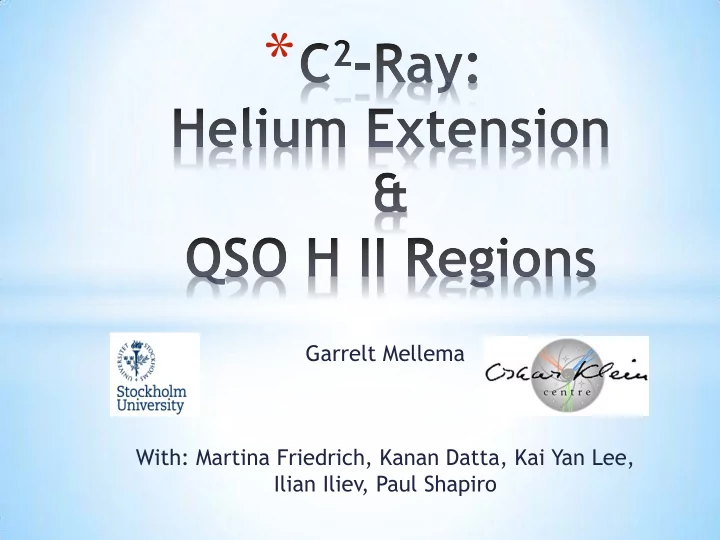

* Garrelt Mellema With: Martina Friedrich, Kanan Datta, Kai Yan Lee, Ilian Iliev, Paul Shapiro
* The C 2 -Ray concept * Including helium * Photo-ionization heating * Application to QSO HII region during reionization * 2 CRTCP IV, Austin, 14 Dec 2012
* Driver: enable time steps >> ionization time step. * Especially useful in combination with hydrodynamics. * Achieved using analytical solution of linearized photo- ionization equations. * Independent of ray tracing algorithm. * 3 CRTCP IV, Austin, 14 Dec 2012
n n Collisional Photo-ionization Recombinations Ionization Photo-Ionization rate Solution of the radiative transfer equation Optical depth between source and position r Non-local connection! * Time-dependent! 4 CRTCP IV, Austin, 14 Dec 2012
* C 2 -Ray photo-ionization rate: with Time-averaged optical depth * 5 CRTCP IV, Austin, 14 Dec 2012
* Derive time-averaged optical depths for H and He. * Include On-The-Spot approximation * Include secondary ionizations * Multi-frequency approach * Friedrich et al. (2012), MNRAS 421, 2232 * 6 CRTCP IV, Austin, 14 Dec 2012
* Time-averaged optical depths are calculated from solution of linearized equations. * When adding helium (without OTS) these equations were solved by Altay et al. (2008). H H I H II H II I * He I He II He III 7 CRTCP IV, Austin, 14 Dec 2012
* Recombinations to the ground states * Recombinations HeIII → HeII n=2 * Deexcitations from HeII n ≥ 2 to ground state (2 photon decay + HeII Ly α ) * 8 CRTCP IV, Austin, 14 Dec 2012
* Excess energy h Δν = h( ν - ν th ): * Heating * If h Δν > h ν th : may produce additional ionization(s). * Depends on h Δν and ionization fractions x. * We use separable relations from Ricotti et al. (2002). * Most works assume x(HII)=x(HeII) and neglect production of HeIII. * 9 CRTCP IV, Austin, 14 Dec 2012
* Photo-ionization integrals can be tabulated. * Function of τ (HI), τ (HeI), τ (HeII) → 3D table! * Solution: use total τ → 1D table! * Complication: ν -dependence of τ’s * Solution: frequency bins. Verner et al. (1996) * Minimum 3, for ~1% errors 1 + 10 + 11 = 22 * 10 CRTCP IV, Austin, 14 Dec 2012
* Same principle as for photo-ionization. * But: heating/photon depends on optical depth! * Optically thin versus optically thick. * Accurate heating accurate optical depth history: non-local effect! * Imposes time step constraints... (Kai Yan Lee). * 11 CRTCP IV, Austin, 14 Dec 2012
12 CRTCP IV, Austin, 14 Dec 2012
* ”Test 2”, but isothermal 13 CRTCP IV, Austin, 14 Dec 2012
* ”Test 4” 14 CRTCP IV, Austin, 14 Dec 2012
* QSOs are powerful sources of ionizing photons. * But: most massive QSOs form in very biased regions. * How large an impact has the QSO on the ionization structure? * Datta et al. (2012), MNRAS 424, 1877 * 15 CRTCP IV, Austin, 14 Dec 2012
* z=7.76 * Most massive halo: M = 1.2 x 10 12 M * Mass ~50% ionized, reionization completes by z~6.5. * Ionization fraction field, 3 cuts 16 CRTCP IV, Austin, 14 Dec 2012
* z=7.57 (23 Myr later) * 17 CRTCP IV, Austin, 14 Dec 2012
* z=7.57 (23 Myr later) * 18 CRTCP IV, Austin, 14 Dec 2012
* 19 CRTCP IV, Austin, 14 Dec 2012
* Total number of ionizing photons during QSO on-time: * N γ (QSO) = 1.7 x 10 71 (2.4 x 10 56 s -1 ) * N γ (stars) = 3.1 x 10 70 (4.3 x 10 55 s -1 ) * Total number of ionizing photons during entire history of region: * N γ (QSO) = 1.7 x 10 71 * N γ (stars) = 2.2 x 10 71 * 20 CRTCP IV, Austin, 14 Dec 2012
* C 2 -Ray algorithm successfully extended to include helium. * Comparison for hydrogen + helium photo-ionization needed. * Accurate photo-heating imposes stricter time step constraints. * Bright QSO may have observable impact but hard to dominate over stars. * 21 CRTCP IV, Austin, 14 Dec 2012
* 22 CRTCP IV, Austin, 14 Dec 2012
* 23 CRTCP IV, Austin, 14 Dec 2012
Recommend
More recommend